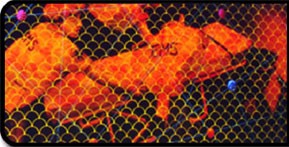A new pre-K to 5th-grade school in Maspeth, Queens, P.S. 58, is named “The School of Heroes” in honor of area men and women who lost their lives during the terrorist attack of September 11, 2001. In the school’s auditorium, a public artwork project includes a multi-paneled mural as a historic timeline and scenes involving that New York City rescue effort. The scenes are a tribute to those in the New York City Fire Department, Police Department, Port Authority Police Department and Emergency Medical Services who worked or lived in Maspeth, Queens, and lost their lives that date. The art project was commissioned by the New York City Department of Cultural Affairs Percent for Art Program.

Entitled “Seen Through the Layers of Time” by artist Amy Cheng, the completed art project was part of an official school ribbon cutting ceremony in November, 2002. The public art includes framing for the auditorium stage in painted panels of Dibond Material that serve as a faux-architectural proscenium and painted mural panels of Dibond Material on either side of the stage, as well as other scenes. Two scenes of the multi-paneled mural depict rescue as performed by the uniformed services. “I wanted the children to be first visually overwhelmed by the color and sense of patterning, and to only later sort out the imagery,” said Cheng. “It was my way of offering them a ‘visual game’ so that they would not tire of the panels even after spending six years at the school. As they grew and learned American history, they would begin to recognize the imagery and understand the references made in the panels.”
Dibond Material was suggested to Cheng by a company that specializes in making backing materials for artists. She also consulted with a fine art conservator “who knew of Dibond and approved of my selection.” Cheng said she selected Dibond Material after a phone conversation with the technical department at 3A Composites USA Inc., the material’s manufacturer. She was sent samples, told of its properties — including rigidity, light weight, and ability to “hold paint well” after a light sandpaper scuffing. The panels were painted with artists’ oil paint; to get the mottled texture, Cheng used plastic wrap. The murals were photographed by Hermann Feldhaus. Before her selection from a group of finalists considered for the art project, Cheng gave a proposal that included her vision of historical panels with an overlay of patterning and the faux architectural stage proscenium. “It was my objective to both delight and inform,” she said. “The panels have a sense of depth created through the optical illusion of layers.” It’s an appropriate technique, given the “Seen Through the Layers of Time” theme.

